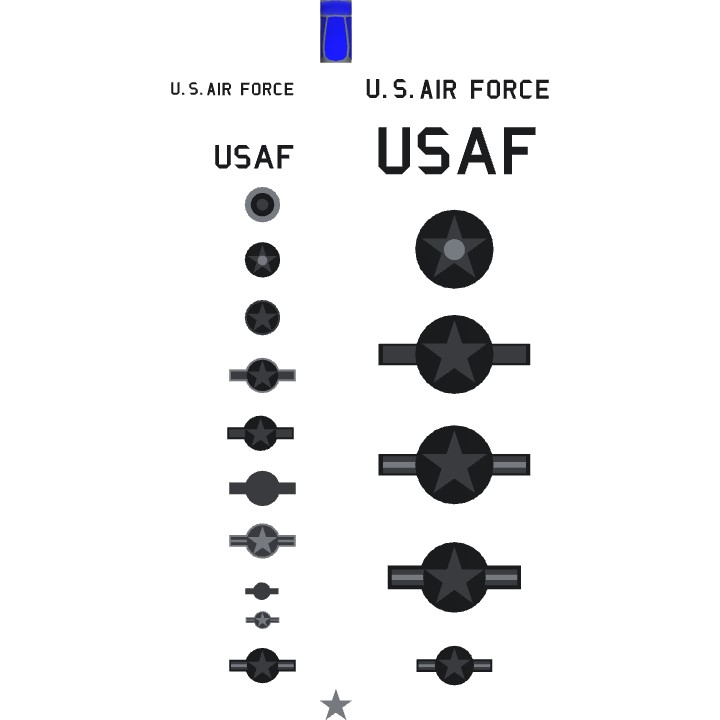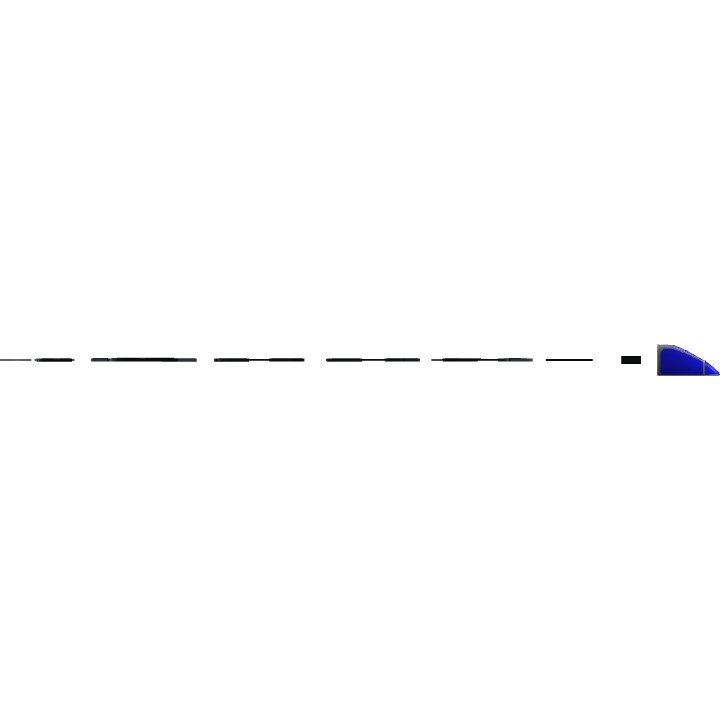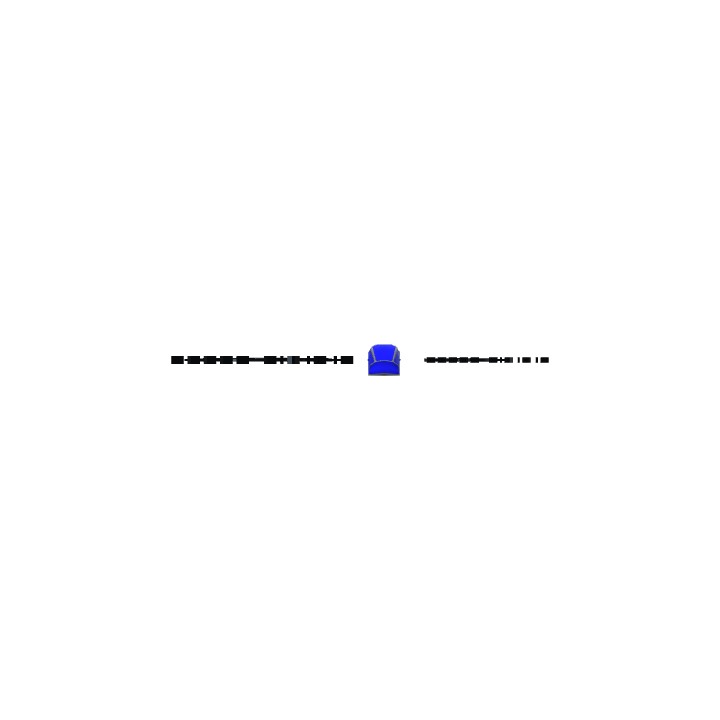INTRO:
As a proud member of the UNITED STATES AIR FORCE, I’ve build many a USAF aircraft during my time with SimplePlanes, a pastime which I have always greatly enjoyed. When just a newbie here, I searched the “Parts” tag as I did not have the know-how to build my own USAF markings for my aircraft. I happened upon @TheAlban’s insignia pack, which was quite helpful for the first year or so, before beginning to build my own insignia…however, his does have its limitations as it’s an early resource before the advent of drag and weight modding. So, I’ve compiled here, for your use, nearly all the national insignia carried by USAF aircraft from 1916 to the present day…ZERO WEIGHT AND ZERO DRAG for your building needs, something which previous insignia packs have not featured. Additionally, some are “light”, consisting of only EIGHT parts, while the others are segmented (many more parts), which aids in “wrapping” them around curved parts. Also, in case anyone was wondering, these are built to official USAF specifications:

HERE’S A BRIEF EXPLANATION OF EACH INSIGNIA:

U.S. Air Force, Segmented, Small: Typically carried on the forward fuselage of USAF aircraft from 1947 on, it is only sporadically present on USAF aircraft today, usually non-camo’d, “full color” jets. This one is segmented vertically so that a builder may wrap it around curved fuselage shapes.
USAF, Small: Typically carried on the upper surface of the right wing and lower surface of the left wing of USAF aircraft from 1947 on; see comment at 1., above.
USAAS WWI Roundel: Used by U.S. Army Air Service from 1918 – 19 in Europe during WWI, this one was actually exactly the same as the Russian Imperial Air Force roundel used prior Russia bowing out!
USAAC/USAAF “Red Dot” Insignia: Used by the U.S. Army Air Corps/Forces 1919-42.
USAAF North Africa Insignia: 1942-43. The U.S. was concerned that AAA gunners with itchy trigger fingers would see the “red dot” and confuse it with the “rising sun” of the Imperial Japanese forces, so they removed the “red dot” and substituted a yellow outline around the blue field. Meant to be used in all theaters, it was primarily used in and associated with the North Africa campaign (Operation Torch).
USAAF Insignia: Used briefly in 1943, this one reincorporated the red element into the insignia.
USAAF Insignia: 1943-47, this one was used throughout WWII and prior to the USAAF becoming an independent service on 18 September, 1947.
USAF Insignia, Subdued: 1980s to present, subdued version of the “Stars and Bars” used on tactical aircraft.
USAF Insignia, Contrasting: 1980s to present, in some cases, contrasting colors may be used instead of grey, such as with this red/black insignia.
USAF Insignia, Subdued, Small: Small version of 8.
USAF Insignia, Contrasting, Small: Small version of 9.
USAF “Star and Bars”, Light: The gloriously full-color national insignia used since the establishment of the United States Air Force on 18 September, 1947. This one is only 8 parts and companion piece to the segmented insignia at 20.
“Red Star” Insignia: During the Mexican Punitive Expedition, the very first U.S. military aviation unit, the 1st Aero Squadron, carried this insignia…which, ironically, looks like the Soviet star insignia…on the tail of their JN-3 “Jenny” biplanes. Mostly painted in red, these stars were also painted in blue.
U.S. Air Force, Segmented, Large: Large version of 1., above.
USAF, Large: Large version of 2., above.
USAAC/USAAF “Red Dot” Insignia, Large: Large version of 4., above.
USAAF Insignia, Large: Large version of 7., above.
USAF “Star and Bars”, Large, Segmented: Large, segmented (to better wrap) version of 12., above.
USAF “Star and Bars”, Large, Light: Large, 8 part version of 12., above.
USAF “Star and Bars”, Segmented: Segmented version of 12., above.
PLACEMENT:
Far too often, I see the national insignia placed on the both wings, the wrong wing or upside down! Before the bars were introduced in 1943, it was correct to place the insignia on the top and bottom of both wings…After the bars became a part of the insignia, it was/is only carried on the top of the left wing and bottom of the right wing...WITH THE STAR POINT FORWARD. When carried, the “USAF” is carried on the opposite wing, see here:

For the fuselage, the national insignia is placed on both sides of the fuselage, in a position where it can remain unobscured…that’s why you will see it on the forward or aft fuselage, depending on type. When carried, the “U.S. Air Force” designation was typically carried on both sides of the forward fuselage.

When you build, good luck and do your research, find pictures and build well. If the variant of the insignia you need isn't present here, you can probably easily modify one of these for your use. I hope these help…fly safe!
ChiChiWerx
Specifications
Spotlights
- Feanor 4.3 years ago
- TMach5 4.3 years ago
- GrizzlitnCFSP 4.3 years ago
- Trainzo 4.3 years ago
- EternalDarkness 4.3 years ago
- FairFireFlight 4.3 years ago
- Wogchamp 4.3 years ago
- Freerider2142 4.3 years ago
- Tang0five 4.3 years ago
General Characteristics
- Predecessor USAF Insignia Pack -- Zero Weight, Zero Drag
- Successors 3 airplane(s) +28 bonus
- Created On Windows
- Wingspan 19.7ft (6.0m)
- Length 37.6ft (11.5m)
- Height 1.6ft (0.5m)
- Empty Weight 551lbs (250kg)
- Loaded Weight 551lbs (250kg)
Performance
- Wing Loading N/A
- Wing Area 0.0ft2 (0.0m2)
- Drag Points 127
Parts
- Number of Parts 1
- Control Surfaces 0
- Performance Cost 832





@ChiChiWerx thanks for tell us here to put the Insignia on own planes because i have been put it in the wrong spot.
gostei mt maninho
This is awesome
man this is good take my updoot and i will leave
These are really nice. Far better than anything I might make.
@Diloph nope. Free to use.
Do I need to credit you?
@ChiChiWerx It was very interesting! np.
@MrPorg137 thank you, I'm glad you took the time to read it.
Very cool! The history of the insignias are nice to read!
Looks awesome! Also your first post in 5 months.@ChiChiWerx
@TheFantasticTyphoon well, at least I feel edified in that at least one user has read my dissertation on the history of the USAF insignia.
@ChiChiWerx
Your modification has much improved its readability.
@TheFantasticTyphoon hmmm...I can see that those with a limited knowledge of WWII history might be confused.
@ChiChiWerx
Whilst that's all true, your description of the insignia appears to suggest that the Japanese fought in North Africa.
@TheFantasticTyphoon well, with a BS in History from USAFA, I agree...the Japanese never fought in N Africa...however, the decision to switch to the yellow outlined insignia was based on the fear that the “red dot” would be mistaken for the Japanese insignia. The yellow outline insignia was meant to be used in all theaters on USAAF aircraft (standardization) ... however, as the strategy at that point of the war called for the major effort to be against Germany and Italy while “holding” the Japanese in the Pacific, the yellow outline is primarily associated with the North Africa campaign, though it was also used in the Pacific and on USN aircraft as well. To this day, that is the case ... Google “Operation Torch Insignia” and see what you get ... But, there are exceptions to every rule and that insignia was used only for a short while. That’s why, for the sake of brevity, I called it the “North Africa Insignia”, though, perhaps, I should have named it the “Yellow Outline Insignia”. But that doesn’t quite ring the same way as the “North Africa Insignia”, does it? You seem to have an interest in WWII history, which I still find immensely fascinating to this day...if you ever would like to discuss the subject, you’ll always find me a willing participant.
The Japs never fought in North Africa. Perhaps you mean the Pacific insignia?
@nameisalreadytaken actually I am planning to build a Soviet interceptor, so I may release some Soviet insignia along with that build.
Why do i like so much your post?? 😄🍻
Very great job .
@ChiChiWerx
Can be
@ChisP yes, I did. That’s a great build, very nice flight model, he worked hard on it and I pointed out some inaccuracies with his markings on his test versions. That inspired me to do this for the community at large.
@ErickvCamilo actually, that would be really simple, especially the modern Brazilian insignia...what exactly are you looking for? The modern roundel by itself?
@ChiChiWerx sweet im working on an f-16 its close to done but needs custom elevators, landing gear, and details which im working on. Didn't you test the f-15 for fairfirefight?
@ChisP yes, you can. That’s the intent, anyway; I’m sure you’ll find a variation which is at least close to what you need. From there, you can scale, tweak, adjust and nudge until it’s close to perfect. Good luck with your building.